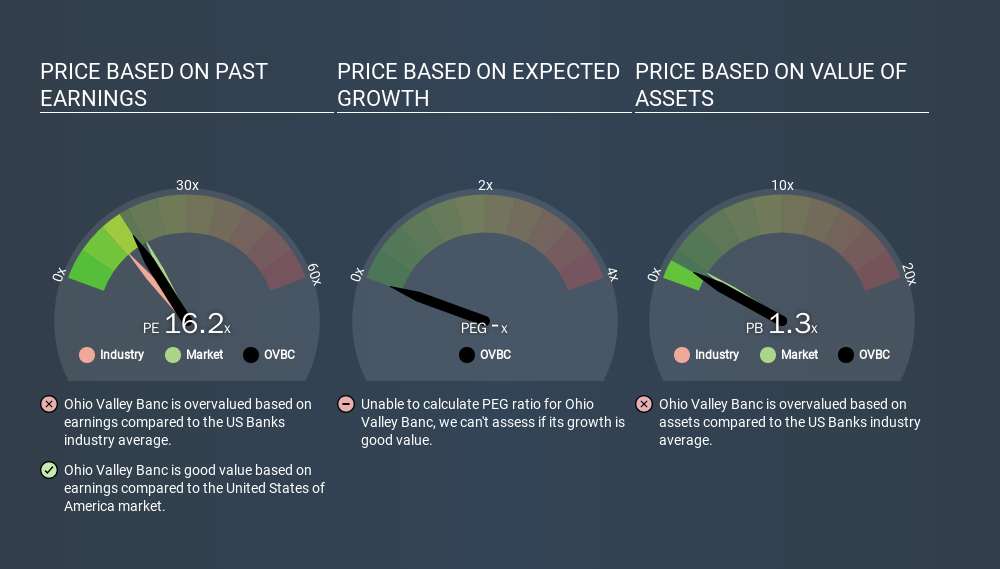- United States
- /
- Banks
- /
- NasdaqGM:OVBC
Should You Be Tempted To Sell Ohio Valley Banc Corp. (NASDAQ:OVBC) Because Of Its P/E Ratio?

Today, we'll introduce the concept of the P/E ratio for those who are learning about investing. We'll look at Ohio Valley Banc Corp.'s (NASDAQ:OVBC) P/E ratio and reflect on what it tells us about the company's share price. Based on the last twelve months, Ohio Valley Banc's P/E ratio is 16.22. In other words, at today's prices, investors are paying $16.22 for every $1 in prior year profit.
Check out our latest analysis for Ohio Valley Banc
How Do You Calculate A P/E Ratio?
The formula for price to earnings is:
Price to Earnings Ratio = Share Price ÷ Earnings per Share (EPS)
Or for Ohio Valley Banc:
P/E of 16.22 = USD33.70 ÷ USD2.08 (Based on the year to December 2019.)
Is A High Price-to-Earnings Ratio Good?
A higher P/E ratio implies that investors pay a higher price for the earning power of the business. All else being equal, it's better to pay a low price -- but as Warren Buffett said, 'It's far better to buy a wonderful company at a fair price than a fair company at a wonderful price'.
How Does Ohio Valley Banc's P/E Ratio Compare To Its Peers?
One good way to get a quick read on what market participants expect of a company is to look at its P/E ratio. The image below shows that Ohio Valley Banc has a higher P/E than the average (12.5) P/E for companies in the banks industry.

Its relatively high P/E ratio indicates that Ohio Valley Banc shareholders think it will perform better than other companies in its industry classification. Clearly the market expects growth, but it isn't guaranteed. So further research is always essential. I often monitor director buying and selling.
How Growth Rates Impact P/E Ratios
P/E ratios primarily reflect market expectations around earnings growth rates. Earnings growth means that in the future the 'E' will be higher. Therefore, even if you pay a high multiple of earnings now, that multiple will become lower in the future. A lower P/E should indicate the stock is cheap relative to others -- and that may attract buyers.
Ohio Valley Banc shrunk earnings per share by 18% over the last year. But over the longer term (5 years) earnings per share have increased by 1.1%.
Don't Forget: The P/E Does Not Account For Debt or Bank Deposits
The 'Price' in P/E reflects the market capitalization of the company. Thus, the metric does not reflect cash or debt held by the company. The exact same company would hypothetically deserve a higher P/E ratio if it had a strong balance sheet, than if it had a weak one with lots of debt, because a cashed up company can spend on growth.
While growth expenditure doesn't always pay off, the point is that it is a good option to have; but one that the P/E ratio ignores.
Ohio Valley Banc's Balance Sheet
Since Ohio Valley Banc holds net cash of US$12m, it can spend on growth, justifying a higher P/E ratio than otherwise.
The Bottom Line On Ohio Valley Banc's P/E Ratio
Ohio Valley Banc has a P/E of 16.2. That's below the average in the US market, which is 18.4. The recent drop in earnings per share would make investors cautious, the relatively strong balance sheet will allow the company time to invest in growth. If it achieves that, then there's real potential that the low P/E could eventually indicate undervaluation.
Investors should be looking to buy stocks that the market is wrong about. As value investor Benjamin Graham famously said, 'In the short run, the market is a voting machine but in the long run, it is a weighing machine. Although we don't have analyst forecasts you could get a better understanding of its growth by checking out this more detailed historical graph of earnings, revenue and cash flow.
Of course you might be able to find a better stock than Ohio Valley Banc. So you may wish to see this free collection of other companies that have grown earnings strongly.
If you spot an error that warrants correction, please contact the editor at editorial-team@simplywallst.com. This article by Simply Wall St is general in nature. It does not constitute a recommendation to buy or sell any stock, and does not take account of your objectives, or your financial situation. Simply Wall St has no position in the stocks mentioned.
We aim to bring you long-term focused research analysis driven by fundamental data. Note that our analysis may not factor in the latest price-sensitive company announcements or qualitative material. Thank you for reading.
About NasdaqGM:OVBC
Ohio Valley Banc
Operates as the bank holding company for The Ohio Valley Bank Company that provides commercial and consumer banking products and services.
Flawless balance sheet average dividend payer.
Similar Companies
Market Insights
Community Narratives



